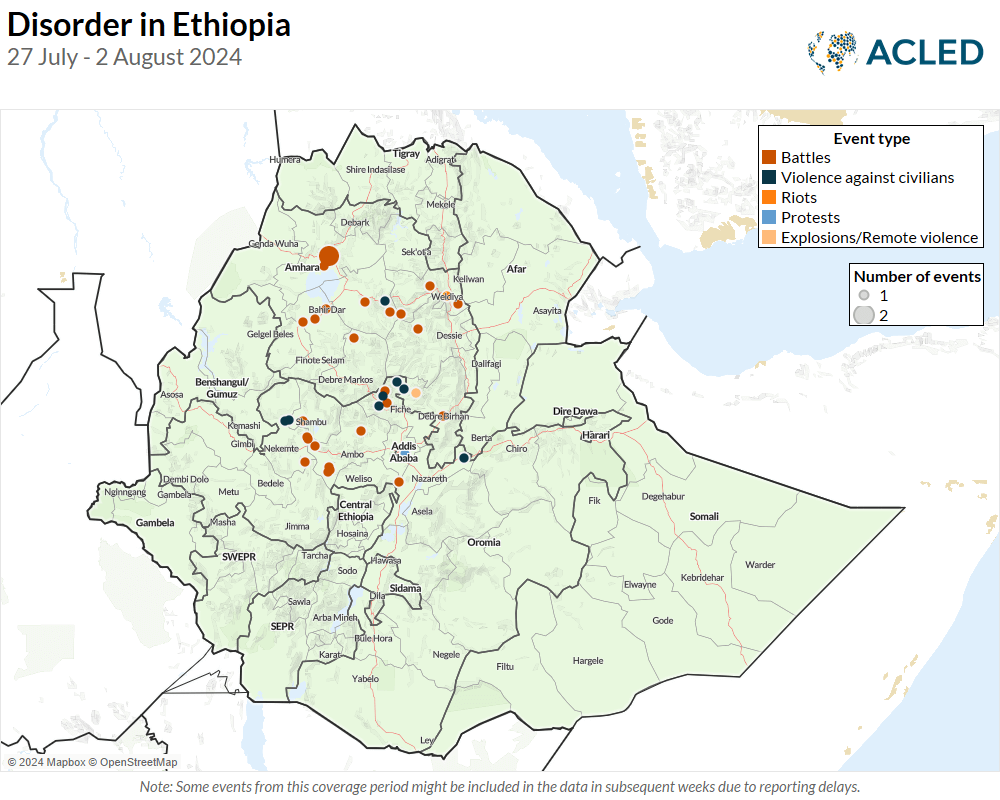Situation summary
The Amhara and Oromia regional governments tightened security measures during the last week, including by imposing additional curfews and expanding military operations targeting insurgents.
Amhara regional authorities react to insecurity
Amhara regional authorities responded last week to an increase in insecurity in the region, as a result of clashes between the Ethiopian National Defense Force (ENDF) and Fano militias. On 28 July, the Bahir Dar City Administration Security Council imposed a new night curfew, prohibiting movement by all unauthorized people in the city after 9 p.m. The Security Council also prohibited carrying weapons within the city. A day earlier, the ENDF claimed to have seized a number of weapons from unidentified individuals in and around Bahir Dar city. Government forces likewise claimed to have conducted an operation targeting Fano militias in East Esite woreda, South Gonder zone.
During the Amhara Regional Council’s session on 31 July, it was revealed that as many as 7,000 prisoners had escaped from 10 prisons since the security crisis in Amhara region began one year ago.1Sisay Sehalu, ‘It was announced that seven thousand prisoners were released from the prison in Amhara region,’ Ethiopian Reporter, 31 July 2024 As the Fano insurgency expanded across the Amhara region, the federal government declared a state of emergency on 4 August 2023. The state of emergency ended in June 2024 after the government announced that it was in firm control of all but eight of the region’s 266 woredas. However, it seems like the government did not manage to re-arrest those who escaped from various prisons. The tightening of security and continued military operations demonstrate the ongoing insecurity in the region. During an address last week to various officials and heads of banks, Prime Minister Abiy Ahmed hinted that the government was engaging in talks with some armed groups in Amhara region, a claim refuted by at least one faction of Fano.2Addis Standard, ‘Ethiopia: PM Abiy claims continuous talks with armed groups, multiple provocation from Tigray forces,’ 2 August 2024; Ethiopia Media Service, ‘EMS Eletawi OLA-OLF’s and Fano’s response to the prime minister Sat 03 Aug 2024,’ 3 august 2024
OLA/OLF-Shane attacks another sugar factory in Oromia
In Oromia region, clashes between the Oromo Liberation Army (OLA) — referred to by the government as the Oromo Liberation Front (OLF)-Shane — and ENDF continued with fighting reported in East Wollega, West Shewa, North Shewa, and Southwest Shewa zones. On 27 July, the OLA/OLF-Shane reportedly kidnapped four employees of the Metehara Sugar Factory, located in East Shewa zone. A similar incident occurred at the factory in February 2023, when four workers were reportedly killed during an attack by OLA/OLF-Shane on the factory.
Sugar factories, mining operations, and other large-scale economic activities have often been a target for OLA/OLF-Shane operatives. In February 2022, Fincha Sugar Factory in Horo Guduru Wollega zone was forced to stop production due to attacks by the OLA/OLF-Shane, with full production only recently resuming in June 2024, incurring a loss of an estimated 4 billion birr (around 50 million US dollars).3Fasika Tadesse, ‘Ethiopian Sugar Plant Stops Work After Attack by Rebel Army,’ Bloomberg, 14 February 2022; VOA Amharic, ‘Fincha Sugar Factory stated that it has suffered more than four billion birr due to security problems,’ 11 June 2024
Elsewhere, the Oromia regional government announced a major operation undertaken by security forces targeting the OLA/OLF-Shane Gidami woreda, Kellem Wollega zone. Based on accounts from locals, the government is conducting forced recruitment to counter the OLA/OLF-Shane, including training sugar factory workers in Horo Guduru Wollega zone.4Wazema, ‘Gachene Sirna! The government of Oromia region is recruiting and training local security guards “forcibly,”’ 31 July 2024

Ethiopia at a Glance
27 July-2 August 2024
The data cover the period from 27 July to 2 August 2024. For more information about how ACLED collects data and categorizes events, see the ACLED Codebook. Some events from this coverage period might be included in the data in subsequent weeks due to reporting delays.
Political Violence Events5This includes the Battles, Explosions/Remote violence and Violence against civilians event types, as well as the Mob violence sub-event type of the Riots event type.: 36
-20% from previous week
Demonstration Events6This includes the Protests event type as well as the Violent demonstrations sub-event type of the Riots event type.: 1
Not applicable from the previous week (no % increase from zero)
Event Types
Battles: 26 Events
Explosions/Remote Violence: 1 Event
Violence Against Civilians: 8 Events
Mob Violence: 1 Event
Protests: 1 Events
Violent Demonstrations: 0 Event





